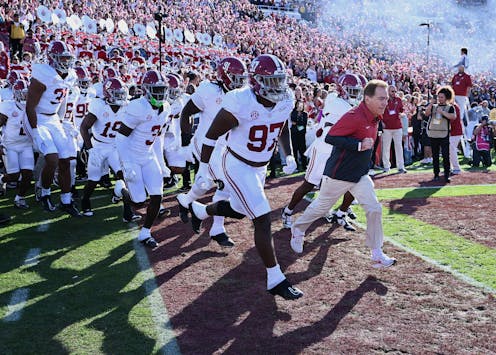Nick Saban’s ‘epic era’ of coaching is over, but the exploitation of players in big-time college foo
Nick Saban was one of the most successful coaches in college football history. But he was not a champion of players’ rights.

When Nick Saban, the legendary University of Alabama football coach, announced his retirement at age 72 in January 2024, various analysts and colleagues depicted his departure as the end of an “epic era” of coaching.
“WOW! College football just lost the GOAT to retirement,” the outspoken University of Colorado coach, Deion Sanders, stated on X. Sanders went on to lament how college football has changed so much that it “chased the GOAT away.”
Without a doubt, Saban’s college coaching record of 297 wins, 71 losses and 1 tie – not to mention seven national championships – puts him in an elite group of college coaches.
However, as the author of a book on the racially exploitative nature of college sports, I don’t see Saban as having been “chased away.” Rather, I see Saban’s retirement as his stepping away from an evolving college sports system that is increasingly empowering athletes in ways that he vocally condemned.
Saban was no champion for college athletes’ rights. Instead, he sought to maintain a status quo that exploited players while enriching coaches, schools and corporate sponsors.
Opposed athlete endorsements and transfer portal
Saban is outspoken about his discontent with recent rule changes concerning name, image and likeness, or NIL. The new rules allow college athletes to sign endorsement deals and profit from their reputation.
Saban felt the NIL changes would allow programs to lure players to their teams by offering more money for the players and their families. In other words, any school with wealthy donors could use enticing NIL packages to secure the top talent and outbid other schools with less resources. Ironically, the NIL changes did not widen the existing recruiting gap between the top Power 5 schools – such as Alabama, Georgia, Ohio State and Louisiana State University – and their peers within the same subdivision.
And yet, had he kept coaching, Saban would have earned a staggering US$11.1 million salary in 2024. That included a $1.1 million annual base salary and a $10 million talent fee, which was to increase $400,000 each year. Talent fees are typically paid by universities using revenue generated from sponsorships and rights deals, and cover being able to use the coach’s NIL. He also was able to benefit from multimillion-dollar endorsement deals from Nike, Chevrolet and other brands as a result of his high-profile coaching status.
Saban also criticized changes to the NCAA transfer portal, which, beginning in 2021, has enabled players to switch schools without having to sit out a year after the transfer. Saban said the portal makes it harder for coaches to maintain player loyalty.
Meanwhile, for years, coaches could leave programs abruptly for better-paying jobs regardless of promises made to their recruits or former players. Saban himself left Louisiana State to coach the NFL’s Miami Dolphins in 2004.
A system that exploits players
College football players are the primary labor force for the multibillion-dollar college sports industry. Given how much money they make for their universities, coaches and corporate sponsors – and the fact that a majority of them will not make it to the NFL – this is a period of their lives when they have a lot of earning power.
But unlike their coaches, who are compensated based on their market value, the players’ compensation – by way of scholarships – are artificially capped. Their earnings are limited to tuition, room and board, a meal plan, termed medical coverage and small stipends.
This means athletes in Power 5 football and Division I men’s basketball are being denied full economic rights, or the opportunity to be paid market value for their labor.
Furthermore, scholarships are not guaranteed each year – a coach can deny an athlete’s scholarship from being renewed. The scholarship agreements also require players to attend practices and meetings, maintain academic eligibility, adhere to in-season and out-of-season coaching mandates, and perform in athletic competitions.
One study of Pac-12 athletes found that players spend on average 50 hours per week on athletics. In addition to attending practices, film sessions and competitions, they have to spend time on athletic training, travel and physical therapy treatments. Although the NCAA has a 20-hour-per-week maximum when it comes to required athletic activities, there are activities that are described as voluntary, even as noncompliance involves penalties.
Then there are injuries.
In a study of 300 college football players, Harvard professors found that one-third reported having had at least one concussion. Two-thirds reported having had one or more injuries of another type. This highlights the occupational hazard and long-term health risks associated with the sport.
A new golden era
In other words, the presumed epic era of coaching excellence that ESPN analysts believe Saban represents was also a period of exploitation and disempowerment for college athletes.
This highly exploitative system is contrary to the NCAA’s stated mission, which claims to value its athletes more than its staff or corporate partners.
And this exploitation has had glaring racial implications.
The Division I coaches, conferences, NCAA and corporate sponsors secured many millions of dollars for themselves while systematically depriving a largely Black college football labor force from earning their market value.
A new bill regarding NIL rights intends to provide federal guidelines for NIL parameters and establish an independent oversight group. Yet the authors of the legislation still seek to prevent college athletes from being classified as employees. Without employee and union status, the benefits that could be achieved through collective bargaining and create a more equitable playing field for college athletes will remain elusive.
Nick Saban will inevitably be inducted into the Hall of Fame. However, his retirement, I believe, does not symbolize the end of a golden era of coaching excellence. Rather, it marks a potential shift toward a true golden era of equitable big-time college sports, one that treats college athletes as deserving of their fair share of the revenues they generate.
Joseph N. Cooper does not work for, consult, own shares in or receive funding from any company or organization that would benefit from this article, and has disclosed no relevant affiliations beyond their academic appointment.
Read These Next
Whether Netflix or Paramount buys Warner Bros., entertainment oligopolies are back – bigger and mor
Hollywood has seen this movie before.
How a niche Catholic approach to infertility treatment became a new talking point for MAHA conservat
Mainstream medical organizations have criticized ‘restorative reproductive medicine,’ but some Catholics…
How I rehumanize the college classroom for the AI-augmented age
A writer instructor recognizes the role of AI on campus, while elevating social connection and humanity…






